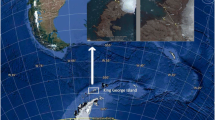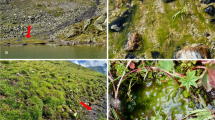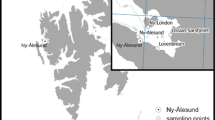Abstract
The McMurdo Dry Valleys in Antarctica are a favorable location for preservation of dormant microbes due to their persistent cold and dry climate. In this study, we examined cultivable bacteria in a series of algal mat samples ranging from 8 to 26539 years old. Cultivable bacteria were found in all samples except one (12303 years old), but abundance and diversity of cultivable bacteria decreased with increasing sample age. Only members of the Actinobacteria, Bacteroidetes, and Firmicutes were found in the ancient samples, whereas bacteria in the 8-year-old sample also included Cyanobacteria, Proteobacteria, and Deinococcus-Thermus. Isolates of the Gram-positive spore-forming bacterium Sporosarcina were found in 5 of 8 samples. The growth of these isolates at different temperatures was related to the phylogenetic distance among genotypes measured by BOX-PCR. These findings suggest that adaptation to growth at different temperatures had occurred among Sporosarcina genotypes in the Dry Valleys, causing the existence of physiologically distinct but closely related genotypes. Additionally, fully psychrophilic isolates (that grew at 15°C, but not 25°C) were found in ancient samples, but not in the modern sample. The preservation of viable bacteria in the Dry Valleys could potentially represent a legacy of bacteria that impacts on current microbial communities of this environment.



Similar content being viewed by others
References
Antibus DE, Leff LG, Hall BL, Baeseman JL, Blackwood CB (2011) Molecular characterization of ancient algal mats from the McMurdo Dry Valleys, Antarctica. Antarct Sci (in press)
Barns SM, Fundyga RE, Jeffries MW, Pace NR (1994) Remarkable archaeal diversity detected in a Yellowstone National Park hot spring environment. Proc Natl Acad Sci USA 91:1609–1613
Billi D, Potts M (2002) Life and death of dried prokaryotes. Res Microbiol 153:7–12
Blackwood CB, Oaks A, Buyer JS (2005) Phylum- and class-specific PCR primers for general microbial community analysis. Appl Environ Microbiol 71:6193–6198
Brambilla E, Hippe H, Hagelstein A, Tindall BJ, Stackebrandt E (2001) 16S rDNA diversity of cultured and uncultured prokaryotes of a mat sample from Lake Fryxell, McMurdo Dry Valleys, Antarctica. Extremophiles 5:23–33
Christner BC, Mosley-Thompson E, Thompson LG, Zagorodnov V, Sandman K, Reeve JN (2000) Recovery and identification of viable bacteria immured in glacial ice. Icarus 144:479–485
Christner BC, Mosley-Thompson E, Thompson LG, Reeve JN (2003) Bacterial recovery from ancient glacial ice. Environ Microbiol 5:433–436
Colwell RK (2005) EstimateS: statistical estimation of species richness and shared species. Version 7.5 User’s guide and application. http://viceroy.eeb.uconn.edu/estimates
Deming JW (2002) Psychrophiles and polar regions. Curr Opin Microbiol 5:301–309
Doran PT, Wharton RA, Lyons WB (1994) Paleolimnology of the McMurdo Dry Valleys, Antarctica. J Paleolimnol 10:85–114
Edgar RC (2004) MUSCLE: multiple sequence alignment with high accuracy and high throughput. Nucleic Acids Res 32:1792–1797
Felsenstein J (2005) PHYLIP (Phylogeny Inference Package) version 3.6. Department of Genome Sciences, University of Washington, Seattle
Franzmann PD, Dobson SJ (1993) The phylogeny of bacteria from a modern Antarctic refuge. Antarct Sci 5:267–270
Gorbushina AA, Kort R, Schulte A, Lazarus D, Schnetger B, Brumsack H, Broughton WJ, Favet J (2007) Life in Darwin’s dust: intercontinental transport and survival of microbes in the nineteenth century. Environ Microbiol 9:2911–2922
Gould GW (2006) History of science–spores. J Appl Microbiol 101:507–513
Hall BL, Denton GH (2000) Radiocarbon chronology of Ross Sea Drift, Eastern Taylor Valley, Antarctica: evidence for a grounded ice sheet in the Ross Sea at the Last Glacial Maximum. Geogr Ann Ser A 82:305–336
Hall BL, Denton GH, Lux DR, Schluchter C (1997) Pliocene paleoenvironment and Antarctic ice sheet behavior: evidence from Wright Valley. Oceanogr Lit Rev 44:1468
Hall BL, Denton GH, Overturf B (2001) Glacial Lake Wright, a high-level Antarctic lake during the LGM and early Holocene. Antarct Sci 13:53–60
Hall BL, Denton GH, Overturf B, Hendy CH (2002) Glacial Lake Victoria, a high-level Antarctic Lake inferred from lacustrine deposits in Victoria Valley. J Q Sci 17:697–706
Hawes I, Howard-Williams C, Vincent WF (1992) Dessication and recovery of Antarctic cyanobacterial mats. Polar Biol 12(6):587–594
Hong SG, Lee YK, Yim JH, Chun J, Lee HK (2008) Sanguibacter antarcticus sp. nov., isolated from Antarctic sea sand. Int J Syst Evol Microbiol 58:50–52
Hughes KA, Nobbs SJ (2004) Long-term survival of human faecal microorganisms on the Antarctic Peninsula. Antarct Sci 16:293–297
Johnson SS, Hebsgaard MB, Christensen TR, Mastepanov M, Nielsen R, Munch K, Brand T et al (2007) Ancient bacteria show evidence of DNA repair. Proc Natl Acad Sci USA 104:14401–14405
Keller MD, Selvin RC, Claus W, Guillard RRL (1987) Media for the culture of oceanic ultraphytoplankton. J Phycol 23:633–638
Kennedy MJ, Reader SL, Swierczynski LM (1994) Preservation records of micro-organisms: evidence of the tenacity of life. Microbiology (Reading Engl) 140:2513–2529
Koeuth T, Versalovic J, Lupski JR (1995) Differential subsequence conservation of interspersed repetitive Streptococcus pneumoniae BOX elements in diverse bacteria. Genome Res 5:408–418
Lehman JT (1976) Ecological and nutritional studies on Dinobryon Ehrenb.: seasonal periodicity and the phosphate toxicity problem. Limnol Oceanogr 21:646–658
Louws FJ, Fulbright DW, Stephens CT, de Bruijn FJ (1994) Specific genomic fingerprints of phytopathogenic Xanthomonas and Pseudomonas pathovars and strains generated with repetitive sequences and PCR. Appl Environ Microbiol 60:2286–2295
Lozupone C, Knight R (2005) UniFrac: a new phylogenetic method for comparing microbial communities. Appl Environ Microbiol 71:8228–8235
McKnight D, Tate C, Andrews E, Niyogi D, Cozzetto K, Welch K, Lyons W, Capone D (2007) Reactivation of a cryptobiotic stream ecosystem in the McMurdo Dry Valleys, Antarctica: a long-term geomorphological experiment. Geomorphology 89:186–204
Morita RY (1975) Psychrophilic bacteria. Bacteriol Rev 39:144–167
Nedwell DB (1999) Effect of low temperature on microbial growth: lowered affinity for substrates limits growth at low temperature. FEMS Microbiol Ecol 30:101–111
Nedwell DB, Russell NJ, Cresswell-Maynard T (1994) Long-term survival of microorganisms in frozen material from early Antarctic base camps at McMurdo Sound. Antarct Sci 6:67–68
Prabahar V, Dube S, Reddy GS, Shivaji S (2004) Pseudonocardia antarctica sp. nov. an Actinomycetes from McMurdo Dry Valleys, Antarctica. Syst Appl Microbiol 27:66–71
Reasoner DJ, Geldreich EE (1985) A new medium for the enumeration and subculture of bacteria from potable water. Appl Environ Microbiol 49:1–7
Reddy G, Prakash J, Vairamani M, Prabhakar S, Matsumoto G, Shivaji S (2002) Planococcus antarcticus and Planococcus psychrophilus spp. nov. isolated from cyanobacterial mat samples collected from ponds in Antarctica. Extremophiles 6:253–261
Reddy GSN, Matsumoto GI, Shivaji S (2003) Sporosarcina macmurdoensis sp. nov., from a cyanobacterial mat sample from a pond in the McMurdo Dry Valleys, Antarctica. Int J Syst Evol Microbiol 53:1363–1367
Renberg I, Nilsson M (1992) Dormant bacteria in lake sediments as palaeoecological indicators. J Paleolimnol 7:127–135
Rollo F, Luciani S, Marota I, Olivieri C, Ermini L (2007) Persistence and decay of the intestinal microbiota’s DNA in glacier mummies from the Alps. J Archaeol Sci 34:1294–1305
Ronimus RS, Rueckert A, Morgan HW (2006) Survival of thermophilic spore-forming bacteria in a 90 year-old milk powder from Ernest Shackelton’s Cape Royds Hut in Antarctica. J Dairy Res 73:235–243
Shivaji S, Reddy GS, Raghavan PU, Sarita NB, Delille D (2004) Psychrobacter salsus sp. nov. and Psychrobacter adeliensis sp. nov. isolated from fast ice from Adelie Land, Antarctica. Syst Appl Microbiol 27:628–635
Spaulding SA, MCKnight DM, Smith RL, Dufford R (1994) Phytoplankton population dynamics in perennially ice-covered Lake Fryxell, Antarctica. J Plankton Res 16:527–541
Spring S, Merkhoffer B, Weiss N, Kroppenstedt RM, Hippe H, Stackebrandt E (2003) Characterization of novel psychrophilic clostridia from an Antarctic microbial mat: description of Clostridium frigoris sp. nov., Clostridium lacusfryxellense sp. nov., Clostridium bowmanii sp. nov. and Clostridium psychrophilum sp. nov. and reclassification of Clostridium laramiense as Clostridium estertheticum subsp. laramiense subsp. nov. Int J Syst Evol Microbiol 53:1019–1029
Sun HJ, Friedmann EI (1999) Growth on geological time scales in the Antarctic cryptoendolithic microbial community. Geomicrobiol J 16:193–202
Surzycki S (2000) Basic techniques in molecular biology. Springer, Berlin
Suzina NE, Mulyukin AL, Kozlova AN, Shorokhova AP, Dmitriev VV, Barinova ES, Mokhova ON, El’-Registan GI, Duda VI (2004) Ultrastructure of resting cells of some non-spore-forming bacteria. Microbiology 73:435–447
Suzina NE, Mulyukin AL, Dmitriev VV, Nikolaev YA, Shorokhova AP, Bobkova YS, Barinova ES, Plakunov VK, El-Registan GI, Duda VI (2006) The structural bases of long-term anabiosis in non-spore-forming bacteria. Adv Space Res 38:1209–1219
Tamura K, Dudley J, Nei M, Kumar S (2007) MEGA4: Molecular Evolutionary Genetics Analysis (MEGA) software version 4.0. Mol Biol Evol 24:1596–1599
Van Trappen S, Mergaert J, Van Eygen S, Dawyndt P, Cnockaert MC, Swings J (2002) Diversity of 746 heterotrophic bacteria isolated from microbial mats from ten Antarctic lakes. Syst Appl Microbiol 25:603–610
Van Trappen S, Vandecandelaere I, Mergaert J, Swings J (2004) Gillisia limnaea gen. nov., sp. nov., a new member of the family Flavobacteriaceae isolated from a microbial mat in Lake Fryxell, Antarctica. Int J Syst Evol Microbiol 54:445–448
Vincent WF (2000a) Evolutionary origins of Antarctic microbiota: invasion, selection and endemism. Antarct Sci 12:374–385
Vincent WF (2000b) Cyanobacterial dominance in the polar regions. In: Whitton BA, Potts M (eds) The ecology of cyanobacteria: their diversity in time and space. Springer, Berlin
Vishnivetskaya T, Kathariou S, McGrath J, Gilichinsky D, Tiedje JM (2000) Low-temperature recovery strategies for the isolation of bacteria from ancient permafrost sediments. Extremophiles 4:165–173
Wiebe WJ, Sheldon WM, Pomeroy LR (1992) Bacterial growth in the cold: evidence for an enhanced substrate requirement. Appl Environ Microbiol 58:359–364
Willerslev E, Hansen AJ, Poinar HN (2004) Isolation of nucleic acids and cultures from fossil ice and permafrost. Trends Ecol Evol 19:141–147
Yi H, Yoon HI, Chun J (2005) Sejongia antarctica gen. nov., sp. nov. and Sejongia jeonii sp. nov., isolated from the Antarctic. Int J Syst Evol Microbiol 55:409–416
Yung PT, Shafaat HS, Connon SA, Ponce A (2007) Quantification of viable endospores from a Greenland ice core. FEMS Microbiol Ecol 59:300–306
Zhang Z, Schwartz S, Wagner L, Miller W (2000) A greedy algorithm for aligning DNA sequences. J Comput Biol 7:203–214
Acknowledgments
This research was funded by the Kent State University and NSF grant MCB-0729783 to Jenny Baeseman.
Author information
Authors and Affiliations
Corresponding author
Additional information
Communicated by M. da Costa.
Rights and permissions
About this article
Cite this article
Antibus, D.E., Leff, L.G., Hall, B.L. et al. Cultivable bacteria from ancient algal mats from the McMurdo Dry Valleys, Antarctica. Extremophiles 16, 105–114 (2012). https://doi.org/10.1007/s00792-011-0410-3
Received:
Accepted:
Published:
Issue Date:
DOI: https://doi.org/10.1007/s00792-011-0410-3




